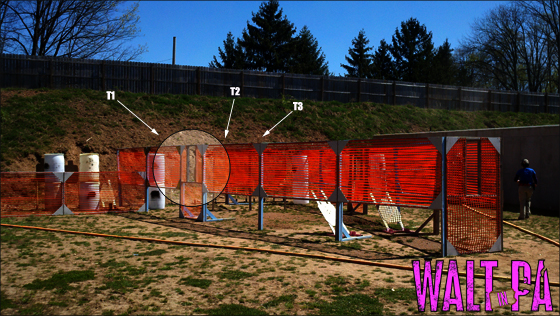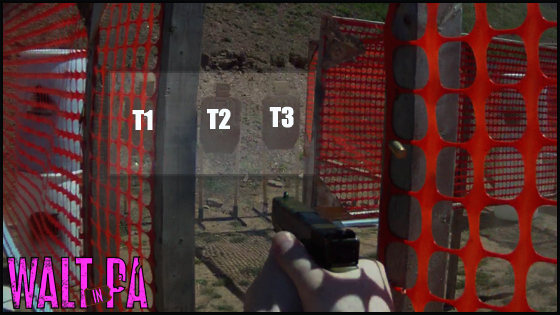When friends and family learn that I like to spend time around sixty to one hundred people walking around with guns on their hips, they always ask “That sounds dangerous, is it safe?” The truth of the matter is, it is very safe and you may be surprised to learn that there are less injuries at this type of shooting competition than there are at many other sporting events. Safety-conscious shooters and strict rules are to thank for that.
Im my limited experience shooting local USPSA matches, I have seen precisely two match disqualifications. The first was at my very first USPSA match when a competitor had a negligent discharge during the “If clear, hammer down and holster” command given by the RO (Range Officer). The second happened just last week while shooting my eighth match on April 7, 2012. The most recent disqualification was due to a shooter breaking what is commonly referred to as the “180 Rule”.
10.5 Match Disqualification – Unsafe Gun Handling
Examples of unsafe gun handling include, but are not limited to:
10.5.2 If at any time during the course of fire, a competitor allows the muzzle of his handgun to point rearwards, that is further than 90 degrees from the median intercept of the backstop, or in the case of no backstop, allows the muzzle to point up range, whether the handgun is loaded or not (limited exceptions: 10.5.6).
My intention is to spend a little time discussing this disqualification and what I have learned from it. Unfortunately, I do not have a copy of the stage briefing, which includes an arial view of the course. Instead, I have a photo of the stage and a still image from my stage video to try and paint the scene for you.
The Stage
The stage in question was setup in what you might imagine as a “V” with a flat bottom (or a blocky “U” with angled vertical lines). The shooter starts the stage by standing infront of the base of the “V” looking through an opening (Port). Through this opening the shooter can see two close range angled targets and eight targets at greater distance.
If you were to move to your left and travel down the vertical line creating the “V”, you would come to another opening in the side wall giving you a closer shot at the long distance targets visible through the previous port. At the base of this leg there was a perpendicular low wall with some targets behind it. The right side of the “V” is essentially a mirror image.
My Video from this Stage
Ports:
The issue at hand was a shooter Breaking the 180. In this case it was a direct result in how the shooter handled the ports. Before I get into what I think the issue was, I want to stress the fact that while I have limited experience with USPSA (this is my second season), I like to think that I’m a student of the sport and do a fair amount of studying to improve my game.
With that said, when it comes to ports there is one piece of advice that I have heard time and time again. Tha piece of advice, Stay out of Ports. It is my understanding that there is little benefit in getting into a port. I’ve heard that a shooter wastes time getting through the port then wastes more time getting out, when most shots came be made while standing away from the port. I’ve also heard that a shooter can have their gun recoil into the port (when the gun is poked through the opening) which may induce a malfunction.
I understand this advice and try to stay out of ports, but bad habits are tough to break. It didn’t dawn on me until this recent match that there is another problem with getting into ports, the shooter can become trapped and inadvertently Break the 180.
Target Arrangement:
The common plan for Production Division shooters was to bisect the course. From the initial port, the shooter would engage the outside target in the far array, and the close range target on an angle. The shooter would then repeat the process for the opposite side of the course (engaging four targets in all before leaving the port). The shooter would then travel down range and engage the remaining three targets through the port (repeating this process on the opposite side of the course when the time came). In the image below, I’ve marked the three remaining targets as T1, T2, and T3.

In the event that the shooter engaged the outer most targets from the first port, the remaining three are not difficult to engage from the port. In the event that you did not shoot the outside target from the first port, you would have to get deep inside the port so that you could see that outside target.
The image below was taken from my match video (posted above) and shows how those three remaining targets are visible without getting into the port. The outside most target is obscured by the stacked barrels in this particular shot and you can see how far the shooter would have to lean through the port in order to get a shot on it.

Breaking the 180:
If this article wasn’t confusing enough, I’m going to make things worse. I said earlier that this stage was a mirror image as far as the ports and target arrangement inside those ports were concerned. The confusing part is that the safety violation occurred on the right side of the course, not on the left as I have shown (I only had images of the left side and wanted to get you up to speed before I went and flipped it on you).
In this case, the shooter proceeded down the left side of the course of fire and got into the port. He engaged the three targets without issue, removed himself from the port and headed up-range to get to the opposite side of the course. Our right handed shooter came down the left side wall and got into the port in much the same way as he did the left side port.
Because the shooter was right handed, he had to get much deeper into the port to see all three targets. Reviewing the match video (which I can’t show you, unfortunately), the shooter had all but his right shoulder through the port. Getting ahead of himself, it appears as though he began to move forward before he was back out of the port. This caused the gun to swing “… further than 90 degrees from the median intercept of the backstop” (According to Rule 10.5.2).
The Aftermath:
The shooter that was disqualified was the shooter that was following me in the rotation. I was half watching him shoot as I reloaded my magazines for the next course of fire. Everything seemed to be going fine when I looked away to grab and handful of rounds from my range bag, when all of a sudden things went quiet.
My first thought was that there was some sort of equipment malfunction but when the talking of my fellow shooters halted and I saw the range officer talking over the shooters shoulder, I knew there must have been some kind of problem. I finished loading my magazines, as the shooter walked off and stood by himself, and the stage was reset. A friend handed me back my borrowed camcorder and I got ready to film him as he stepped up to the start position.
A bit later I pulled up the shooters video so that he could see what he had done. I didn’t bother to watch it on the tiny FlipCam screen and reviewed the footage on my compter when I returned home. I would love to show you the footage but at the request of the shooter, I can not share it.
The video shows the violation clearly and it appears as though the Range Officer handled the situation professionally (you can’t hear what he is saying, but his body language appeared as though he really didn’t want to issue the disqualification).
When I watched the video for the first time, I had mixed feelings. The Range Officer looked as if he saw the violation coming and stepped away from the shooter. I wondered why the Range Officer didn’t issue a verbal warning to prevent it from happening, but watching the video several times showed that it just happened too fast. The gun was in a safe direction one second and the next it was in an unsafe direction. I think that perhaps the Rango Officer stepped back to get a better view of the shooter, through the port, before the violation occurred.
I can only hope that the shooter learned as much from this experience as I have. Getting into ports can lead to slower shooting, malfunctions, and in a worse case scenario, aide in Breaking the 180, resulting in a match disqualification.
10 thoughts on “USPSA: Dissecting a Disqualification”
Comments are closed.
Recent Posts
Why Fall is the Best Time for Motorcycle Riding (And How Summer Nearly Killed My Passion)
There's something magical about fall motorcycle riding that makes all the summer suffering worthwhile. As I sit here in my garage with a good cigar and a bourbon, looking at the cool September air...
From Group Ride Roasts to Real Life: My YouTube Channel Update
Well, my lovelies (I realize that sounds weird but at this point I need to lean into it), it's time for some real talk about where I've been and what's been happening behind the scenes at Walt in...


Speaking from an IDPA point of view so take with a grain of salt.
I am sorry but the the DQ is also (mostly) the fault of the stage designer. In the video, from 00:39 to 00:42, the shooter is forced to manipulate the gun into an unnatural position. Not only that, I am willing to bet that more than one shooter (I think you included) swept himself (non-shooting hand/arm swinging) as he ran back upstage.
The more I look at the stage, the more boneheaded the design looks. An alternative would have been to get rid of the barrels for the 2 extreme left targets and have the shooter shoot while walking backwards safely (Retreating. No idea if it is allowed in IPSC) that way not only the muzzle but the whole body would be facing the berm.
Take this stage as example when you design: If you force a shooter to do stupid crap, feces will happen, DQs will be given unnecessarily or people will get injured. Safety prevails over coolness.
The other principle is that whenever you think you designed something that is foolproof, somebody is bound to make a liar out of you.
Miguel,
I appreciate the feedback. I looked more closely at the portion of the stage where I was retreating. I’m not sure that I swept myself but I most certainly should have had the gun a bit higher. I’ll keep that in mind next time.
Moving in the way that I did was actually more natural than the way some of the other shooters addressed the stage. Imagine a right handed shooter, starting on the right, and retreating back up-range to engage the targets down the left side of the wall. There is no easy way to do it and you end up with shooters running, right arm extended, behind them (Gun is in a safe direction but it is very awkward)
There is no rule (that I am aware of) on retreating and shooters could have backed all the way up to get back around the course. Those two extreme targets (one on each side) could have been engaged from the first port. Some shooters (very few, actually) didn’t feel comfortable engaging them from that distance. Their only option at that point was to practically climb through the port to see them.
I know it is like comparing apples and oranges, but I’d love to see how this stage would be designed with IDPA in mind. I don’t know if something this large is used in IDPA, but a side by side comparison would be interesting.
You could have just linked to my DQ. LOL!
Thanks for the comment, I clicked through and read the post, very informative.
I’m curious though, what would have been the safe way to retreat in that stage (I’m not familiar with IDPA)? Should you have ran backwards with your gun and body pointed downrange or is it acceptable to run back to the table (for your reload), with the gun pointed downrange, behind you?
Challenge Accepted! 🙂
Made a quick hash of it. It is not IDPA legal (number of total shots) but close enough for government work.
Version 1
http://gunfreezone.net/wordpress/wp-content/uploads/2008/10/walt-stage-1.jpg
Version 2
http://gunfreezone.net/wordpress/wp-content/uploads/2008/10/walt-stage-2.jpg
These are MY versions and probably not condoned by IDPA. I hope I didn’t mess the number of targets.
Also, it can be shot mirror image if the shooter wishes as long as he applies the instructions also mirror image or the shooter can be told that if he is right handed, he must shoot from the left first and viceversa. Make them suffer just a tad.
Miguel,
I’m getting a 403 Forbidden error when I try to access the images you linked (I’m guess it is caused by whatever you are used to prevent leeching of your bandwidth)
Miguel,
I got it straightened out. I had a feeling it was your anti-leeching setup so I went to your blog then copy/pasted the image url into the browser. Going to the images from within your blog allowed me to see them.
I like the Macanudo and Passion Fruit Smoothie (I’m more of a mixed berry man, though…. LOL) mentions. That was a nice touch.
PS: Now that I think about it, I should have the shooter start at P1 seating in a chair with a cigar in one hand and a smoothie in the other hand. It is always fun to see crap & chairs flying as the shooter gets up and goes for his gun.